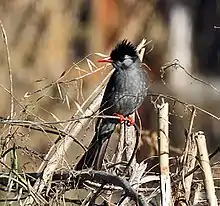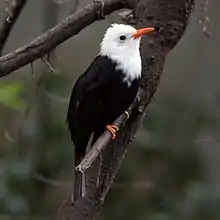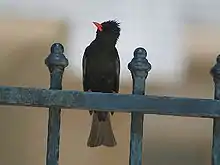Black bulbul
The black bulbul (Hypsipetes leucocephalus), also known as the Himalayan black bulbul or Asian black bulbul, is a member of the bulbul family of passerine birds. It is found primarily in the Himalayas, its range stretching from India eastward to Southeast Asia. It is the type species of the genus Hypsipetes, established by Nicholas Aylward Vigors in the early 1830s.[2] There are a number of subspecies, mostly varying in the shade of the body plumage which ranges from grey to black, and some also occur in white-headed morphs, as also suggested by its specific epithet leucocephalus, literally "white head". The legs and bill are always rich orange-red.
| Black bulbul | |
|---|---|
 | |
| H. l. psaroides | |
| Scientific classification | |
| Kingdom: | Animalia |
| Phylum: | Chordata |
| Class: | Aves |
| Order: | Passeriformes |
| Family: | Pycnonotidae |
| Genus: | Hypsipetes |
| Species: | H. leucocephalus |
| Binomial name | |
| Hypsipetes leucocephalus (Gmelin, 1789) | |
| Synonyms | |
| |
Taxonomy and systematics

The black bulbul was originally described in the genus Turdus and has also been considered as either conspecific with or as subspecies of the Malagasy bulbul.[3] The common name 'black bulbul' is also used as an alternate name by the Malagasy bulbul. Formerly, the square-tailed bulbul was also classified as two subspecies of the black bulbul.
Subspecies
Ten subspecies are currently recognized, although the reproductive isolation mechanisms such as vocalization and geographic distributions of these populations still remain to be studied:[4][5]
- H. l. psaroides - Vigors, 1831: Originally described as a separate species. Found along the Himalayas from the Kunar Valley (north-eastern Afghanistan) and northern Pakistan through Arunachal Pradesh (northern India) and the central Himalayas to north-western Myanmar
- Assam black bulbul (H. l. nigrescens) - Baker, ECS, 1917: Found in Assam and Manipur (north-eastern India), and the Chin Hills (western Myanmar)
- Burmese black bulbul (H. l. concolor) - Blyth, 1849: Originally described as a separate species. Found from eastern Myanmar and southern Yunnan (southern China) through Indochina
- H. l. ambiens - (Mayr, 1942): Found in north-eastern Myanmar and western Yunnan (southern China)
- H. l. sinensis - (La Touche, 1922): Found in northern Yunnan (southern China)
- H. l. stresemanni - (Mayr, 1942): Members of this race have white heads. Found in central Yunnan (southern China)
- H. l. leucothorax - (Mayr, 1942): Members of this race have white heads. Found in central China
- H. l. leucocephalus - (Gmelin, JF, 1789): Members of this race have white heads. Found in south-eastern China
- H. l. nigerrimus - (Gould, 1863): Originally described as a separate species. Found in Taiwan
- H. l. perniger - R. Swinhoe, 1870: Originally described as a separate species. Found on Hainan (off south-eastern China)
Description



The black bulbul is 24–25 cm (9.4–9.8 in) in length, with a long tail. The body plumage ranges from slate grey to shimmering black, depending on the race. The beak, legs, and feet are all orange and the head has a black fluffy crest. Sexes are similar in plumage, but young birds lack the crest, have whitish underparts with a grey breast band, and have a brown tint to the upperparts. They have a black streak behind the eye and on the ear coverts.[6][7][8]
Distribution and habitat
This bulbul is found in broad-leaved forests, cultivation and gardens mainly in hilly areas, but Himalayan populations are known to sometimes descend into the adjoining plains in winter.[10][11][12]
Breeding
It builds its nest in a tree or bush; the nest is a cup placed in a fork and made from grasses, dry leaves, mosses, lichens and cobwebs. The lining is made up of ferns, rootlets and other soft material.[13] Both sexes participate in nest construction. Two or three eggs form the usual clutch.
Food and feeding
Black bulbuls feed mainly on seeds and insects, and they are often seen in small groups, either roosting or flying about in search of food. They are particularly fond of berries. They are known to feed on a wide range of berries including Celtis, Rosa, Melia and Ehretia in the Himalayas.[14] They feed on the nectar of Salmalia, Erythrina, Rhododendron and other species. They make aerial sallies for insects.[10]
.jpg.webp)
References
- BirdLife International (2016). "Hypsipetes leucocephalus". IUCN Red List of Threatened Species. 2016: e.T103823996A94366953. doi:10.2305/IUCN.UK.2016-3.RLTS.T103823996A94366953.en.
- Gregory, Steven M. S. (2000). "Nomenclature of the Hypsipetes Bulbuls (Pycnonotidae)" (PDF). Forktail. 16: 164–166.
- Warren, Ben H.; Bermingham, Eldredge; Prys-Jones, Robert P. & Thebaud, Christophe (2005). "Tracking island colonization history and phenotypic shifts in Indian Ocean bulbuls (Hypsipetes: Pycnonotidae)" (PDF). Biological Journal of the Linnean Society. 85 (3): 271–287. doi:10.1111/j.1095-8312.2005.00492.x.
- Dickinson, E.C.; Dekker, R.W.R.J.; Eck, S. & Somadikarta, S. (2002). "Systematic notes on Asian birds. 26. Types of the Pycnonotidae". Zool. Verh. Leiden. 340: 115–160.
- Gill, Frank; Donsker, David (eds.). "Bulbuls". IOC World Bird List. International Ornithologists' Union. Retrieved 31 October 2017.
- Ali, S & S D Ripley (1996). Handbook of the birds of India and Pakistan. 6 (2nd ed.). Oxford University Press. pp. 109–113.
- Blanford WT (1889). The Fauna of British India, Including Ceylon and Burma: Birds Volume 1. Taylor and Francis, London. pp. 259–263.
- Baker, ECS (1924). The Fauna of British India, Including Ceylon and Burma. Birds. 1 (2nd ed.). Taylor and Francis, London. pp. 368–373.
- Page, WT (1903). "The Himalayan Black Bulbul. Hypsipetes psaroides". Avicultural Magazine. 1 (6): 209–211.
- Rasmussen PC & JC Anderton (2005). Birds of South Asia. The Ripley Guide. Volume 2. Smithsonian Institution & Lynx Edicions. pp. 342–344.
- Raza, Rashid H. (1993). "Sighting of Black Bulbul Hypsipetes madagascariensis (P.L.S. Muller) in Gaya, Bihar". Journal of the Bombay Natural History Society. 90 (2): 291.
- Gaston, AJ (1972). "Black Bulbuls Hypsipetes madagascariensis (P.L.S. Muller) in Delhi". Journal of the Bombay Natural History Society. 69 (3): 651–652.
- Hume, A.O. (1889). The nests and eggs of Indian birds. 1 (2nd ed.). R H Porter, London. pp. 164–168.
- Narang, ML; Rana, RS (1999). "Black Bulbuls association with Melia azedarach". Newsletter for Birdwatchers. 38 (6): 104.
